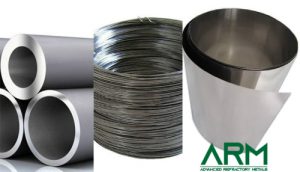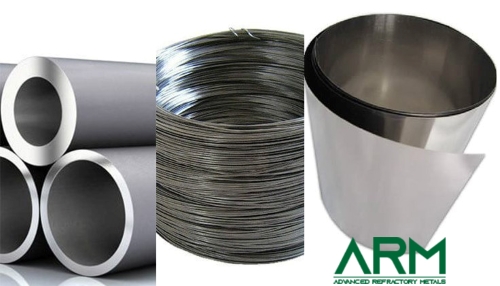Introduction
Zirconium alloys are known for their exceptional corrosion resistance, mechanical strength, and thermal stability, making them suitable for a variety of demanding applications. Among the most widely used zirconium alloys are Zr 702, Zr 704, and Zr 705. Each grade has distinct properties and applications, tailored to meet specific industrial needs.

1. Zr 702: Commercially Pure Zirconium
Zr 702 is considered a commercially pure grade of zirconium, with a zirconium content of at least 99.2%. It contains very low levels of alloying elements such as iron, oxygen, and hafnium.
Key Properties
- Corrosion Resistance: Exceptional resistance to most acids, alkalis, and seawater, making it highly effective in harsh chemical environments.
- Ductility: Excellent ductility allows for easy forming, machining, and welding.
- Thermal Stability: High melting point and stability in elevated temperatures.
Applications
- Chemical Processing: Used for equipment like heat exchangers, reactors, and storage tanks in chemical industries.
- Nuclear Reactors: Utilized as cladding for fuel rods due to its low neutron absorption.
- Medical Applications: Used in medical implants and devices due to its biocompatibility.
- Marine Applications: Suitable for seawater systems and marine hardware because of its resistance to saltwater corrosion.
2. Zr 704: Zirconium Alloy with Improved Strength
Zr 704 is an alloyed grade of zirconium that includes small amounts of niobium (0.5%-2.5%), iron (0.2%-0.4%), and oxygen. The added elements enhance its strength while maintaining excellent corrosion resistance.
Key Properties
- Higher Strength: Enhanced mechanical strength compared to Zr 702 due to the alloying elements.
- Corrosion Resistance: Excellent resistance to oxidizing and reducing environments, particularly in acidic solutions.
- Good Fabricability: Retains good ductility for forming and welding.
Applications
- Chemical and Petrochemical Industries: Commonly used for vessels, piping, and heat exchangers handling strong acids and other corrosive substances.
- Aerospace Components: Ideal for components requiring high strength-to-weight ratios and resistance to high-temperature oxidation.
- Hydrogen Storage: Utilized in hydrogen storage systems due to its stability and ability to resist hydrogen embrittlement.
3. Zr 705: Zirconium-Niobium Alloy
Zr 705 is a high-strength zirconium alloy containing 2%-3% niobium, along with small amounts of iron and oxygen. The addition of niobium significantly increases its strength and enhances its resistance to mechanical stress.
Key Properties
- Exceptional Strength: Significantly stronger than Zr 702 and Zr 704, making it suitable for applications requiring high mechanical performance.
- Corrosion Resistance: Maintains excellent corrosion resistance in most acidic and alkaline environments.
- Fatigue Resistance: High resistance to cyclic stresses, making it ideal for dynamic or high-stress environments.
Applications
- Nuclear Applications: Commonly used in advanced reactor designs where strength and corrosion resistance are critical.
- Aerospace and Defense: Ideal for high-performance components in aerospace and defense systems.
- Chemical Processing: Used for high-pressure vessels and piping in extreme chemical environments.
- Medical Implants: Applied in high-load orthopedic implants due to its strength and biocompatibility.
Choosing the Right Grade
| Property | Zr 702 | Zr 704 | Zr 705 |
| Composi
-tion |
Commercially
pure zirconium (>99.2%) |
Zirconium
with Fe, Nb, and O additives |
Zirconium
with 2%-3% Nb, Fe, and O |
| Strength | Moderate | Higher than
Zr 702 |
Significantly
higher than Zr 702/704 |
| Corrosion
Resistance |
Excellent | Excellent | Excellent |
| Ductility | High | Moderate
to high |
Lower than
Zr 702, higher than many alloys |
| Applica
-tions |
Chemical,
nuclear, and medical |
Chemical,
petrochemical aerospace |
Nuclear,
aerospace, chemical, medical |
(Note: For more zirconium grades information, please check Advanced Refractory Metals (ARM).)
- Zr 702: Best for applications where corrosion resistance and ductility are priorities, such as chemical processing, marine systems, and medical implants.
- Zr 704: Ideal for environments requiring a balance of strength and corrosion resistance, such as high-temperature or acidic chemical processes.
- Zr 705: Suitable for high-stress and high-performance applications, including aerospace, defense, and advanced nuclear reactors.
Each grade of zirconium is engineered to meet specific industrial challenges, ensuring optimal performance, safety, and durability. Selecting the right grade depends on the application’s mechanical, environmental, and operational demands.
